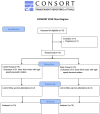The influence of electrical high-speed rotation on mandibular third molar surgeries: a prospective, randomized, split-mouth clinical and radiographic study
- PMID: 38632471
- PMCID: PMC11024200
- DOI: 10.1038/s41598-024-59611-5
The influence of electrical high-speed rotation on mandibular third molar surgeries: a prospective, randomized, split-mouth clinical and radiographic study
Abstract
The aim of this split-mouth randomized clinical trial was to evaluate the clinical outcomes (operative time, edema, trismus, and pain), the immediate histological effects, the alveolar repair (2 and 4 months), and the quality of life after the extraction of impacted third molars using high-speed pneumatic and electrical rotation. Sixteen patients underwent extraction of the two mandibular third molars with a minimum interval of 15 days. On one side of the participant's mouth, high-speed pneumatic rotation was used (Control Group-CG) while for the other side, high-speed electrical rotation was used (Study Group-SG). Statistical analysis included ANOVA repeated measures and Pearson correlations. SG group showed: shorter operative time (p = 0.019), less pain (p = 0.034), swelling (p < 0.001) and trismus (p = 0.025) on the 1st postoperative day; less pain (p = 0.034) and trismus (p = 0.010) on the 3rd postoperative day; less trismus (p = 0.032) on the 7th postoperative day; and better quality of life (p = 0.007). No differences were observed for peripheral bone damage or bone density of alveolar repair at 2 and 4 months between groups. Electric high-speed rotation provided better postoperative clinical parameters of pain, edema and trismus when compared with pneumatic high-speed rotation for mandibular third molar surgery.Trial registration: Brazilian Registry of Clinical Trials registration number RBR-4xyqhqm ( https://ensaiosclinicos.gov.br/rg/RBR-4xyqhqm ).
Keywords: Bone regeneration; Molar, third; Oral surgical procedures; Osteotomy; Tooth extraction.
© 2024. The Author(s).
Conflict of interest statement
The authors declare no competing interests.
Figures








Similar articles
-
Influence of surgical ultrasound used in the detachment of flaps, osteotomy and odontosection in lower third molar surgeries. A prospective, randomized, and "split-mouth" clinical study.Med Oral Patol Oral Cir Bucal. 2020 Jul 1;25(4):e461-e467. doi: 10.4317/medoral.23447. Med Oral Patol Oral Cir Bucal. 2020. PMID: 32388527 Free PMC article. Clinical Trial.
-
An Evaluation of the Effect of Using Irrigations at Different Temperatures on Pain, Edema, and Trismus during the Extraction of Bilateral Impacted Mandibular Third Molars: A Randomized Split-Mouth Clinical Trial.Niger J Clin Pract. 2023 Dec 1;26(12):1921-1926. doi: 10.4103/njcp.njcp_488_23. Epub 2023 Dec 29. Niger J Clin Pract. 2023. PMID: 38158362 Clinical Trial.
-
The effect of hyaluronic acid addition to collagen in reducing the trismus and swelling after surgical extraction of impacted lower third molars: a split-mouth, randomized controlled study.Clin Oral Investig. 2023 Aug;27(8):4659-4666. doi: 10.1007/s00784-023-05092-1. Epub 2023 May 31. Clin Oral Investig. 2023. PMID: 37256430 Clinical Trial.
-
Piezoelectric Versus Conventional Rotary Techniques for Impacted Third Molar Extraction: A Meta-analysis of Randomized Controlled Trials.Medicine (Baltimore). 2015 Oct;94(41):e1685. doi: 10.1097/MD.0000000000001685. Medicine (Baltimore). 2015. PMID: 26469902 Free PMC article. Review.
-
Surgical techniques for the removal of mandibular wisdom teeth.Cochrane Database Syst Rev. 2020 Jul 26;7(7):CD004345. doi: 10.1002/14651858.CD004345.pub3. Cochrane Database Syst Rev. 2020. PMID: 32712962 Free PMC article.
Cited by
-
Comparative analysis of bone healing in subcritical defects with air turbine and electric handpiece in a rat model.PLoS One. 2024 Dec 30;19(12):e0312280. doi: 10.1371/journal.pone.0312280. eCollection 2024. PLoS One. 2024. PMID: 39774839 Free PMC article.
-
Evaluating quality of life in third molar surgery: a scoping review of the postoperative symptom severity (PoSSe) scale.Med Oral Patol Oral Cir Bucal. 2025 Mar 1;30(2):e232-e239. doi: 10.4317/medoral.26839. Med Oral Patol Oral Cir Bucal. 2025. PMID: 39954280 Free PMC article.
References
-
- Azam K, Hussain A, Maqsood A, Farooqui WA. Effects of surgery duration on post-extractionsequelae following impacted third molar surgeryby using two different bone cutting methods: A double blind randomized trial. Pak. J. Med. Sci. 2016;36:8–12.
Publication types
MeSH terms
LinkOut - more resources
Full Text Sources

